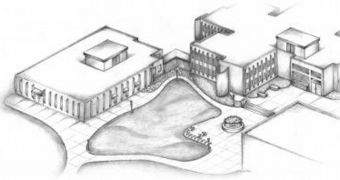Experts at the US Department of Energy's (DOE) Sandia National Laboratories, in Livermore, are about to get a gift only scientists appreciate. Their existing Combustion Research Facility (CRF) will be augmented by another building, the Combustion Research Computation and Visualization (CRCV) station. The groundbreaking ceremony for the new addition will take place tomorrow, March 24, at 2 PM. The $5 million investment is scheduled to be completed and operational by this October.
The funding for the investment was provided by the DOE Office of Science and the DOE Office of Energy Efficiency and Renewable Energy (EE). They awarded the funds because they recognized the important contributions that enhanced computational and modeling efforts could bring to the overall work portfolio of the CRF. “Combustion will almost certainly be part of our energy future for decades to come. Predictive modeling is a key enabler for the transportation industry, so this new computational facility will be an integral part of our efforts,” says the director of the SNL Transportation Energy Center, Bob Carling.
The official also added that understanding combustion was still one of the most difficult task facing scientists. Combustion and computer experts will work together in the new building, which will feature, in addition to a large room for holding computer clusters, new offices, visualization equipment, and collaboration spaces. “The building will provide a focal point to further attract leading researchers to develop the methodologies needed to perform and analyze high-fidelity simulations of reacting flows and chemical systems. It will enable wider access to these massive datasets, expand our collaborator base, and enable even greater ties between experimental and computational programs at the CRF and beyond,” he explains further.
With the new CRCV facility, experts will be able to enter deep into the heart of the turbulences and chemical interactions that underline, for example, the way turbulent flames work. Though it may appear simple at first, this line of investigations requires highly intensive computational capabilities, which will all be housed at the new building. All the models that will be built to test whatever predictions come out of the new approach to simulation will also be constructed at the new facility. “The new building will allow researchers to collaborate much more effectively and will provide the high-end visualization tools that are necessary for this kind of work,” Carling concludes.

 14 DAY TRIAL //
14 DAY TRIAL //